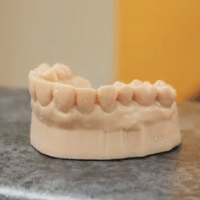Dental Bridges – What Are They and How Do They Work?
A Dental Bridge is used to replace missing teeth. They are cemented or bonded to the teeth beside the space so they are fixed in place and cannot be removed. In times past they were used a lot more commonly, but with the widespread use of implants, their use has decreased. Bridges can also be used to join multiple implants, but we are only going to discuss tooth-supported bridges.
What is a Dental Bridge?
A dental bridge consists of two parts

Conventional Bridge showing preparation of Abutment Teeth
1. The abutment or retainer. This is attached to a tooth or both teeth beside a space. It can be in the form of a crown which slips over the tooth and covers it completely (Conventional Bridge), or a wing which bonds to the inside of the tooth next door (Maryland or Resin Retained Bridge). Conventional Bridges which attach to the teeth on either side are stronger and more durable than Maryland Bridges, however they require more preparation (drilling away) of the teeth to make space for the crowns.
2. The Pontic. This is the missing tooth which fills the space. This sits on top of the gum, but does not go into the gum. Becuse it sits flush with the gum, food does not tend to get caught under there, but you do need to be able to clean that area.
What is a Dental Bridge made of?
Bridges tend to be made of ceramics. These provide a good blend of strength, stability and aesthetics. To provide extra strength, they are often supported by a layer of a stronger material on the inside to give additional strength and durability. Traditionally this was a a metal alloy, but as materials have improved over time the use of Zirconia (which is white) is becoming more common to give even better aesthetics.
In certain cases bridges can be made of fibre reinforced resin, however these bridges lack the strength of Ceramic bridges and are generally used as medium term solutions as a compromise due to financial constraints.
What materials are used depends on a number of factors including
- the size of the space
- the location in the mouth
- the forces which will be applied (how heavy the bite is)
- the condition of the other teeth
When are they used?
As mentioned earlier, bridges are used less commonly than in the past because of the predictability of implants. Implants are generally preferred because they are a self supporting tooth replacement, that is they don’t rely on other teeth on support them. There are times when a bridge may be a suitable option.
- You already have a bridge which needs replacing.
- You do not have enough bone for an implant to be placed.
- You have medical issues which makes Implant surgery potentially risky eg smoker, Periodontal Disease, Radiation therapy for Cancer.
- You find the thought of Implant surgery too distressing.

Before – Partial denture replacing missing front tooth

After -Resin Retained Bridge replacing missing front tooth
Are there different types of Dental Bridge?
There are two main types of Bridges:
- Conventional Bridge: These involve preparing (Cutting back) the teeth on either side of the missing tooth. A Bridge is then made consisting of crowns on the missing tooth and a false tooth in the middle. This is all joined together and cemented in place. It is designed to look, feel and work like natural teeth. The false tooth fits snugly against the gum to minimize the amount of food that can get caught underneath. It can provide a very strong and long lasting way to replace a missing tooth.
- Resin Retained (Maryland) Bridge: These involve bonding a wing or retainer to the back of one of the teeth beside the space. This type of bridge involves little or no preparation of the teeth, and is usually only bonded to one tooth. For this reason it is more conservative than a conventional bridge. It is not, however as strong or durable.

Resin retained Bridge showing the wing and the false tooth
How long do they last?
This is a little bit of a tricky question as how long things last depends on a huge number of factors:

Bridge replacing 2 missing lower front teeth after 5 yrs.
- How strong the teeth are which are supporting the bridge. For example bridges which are supported by teeth which have had root canal treatments have been shown to be less durable than those where the supporting (abutment) teeth are vital (haven’t had root canal treatment)
- How many missing teeth the bridge needs to replace.
- How much force they will be under. (As you get further back in the mouth the biting forces get stronger, and some people naturally have heavy bites)
- How clean they are kept. It is a little more effort to clean around abridge than natural teeth, as the teeth are joined together. If they are not kept clean then decay can happen on the supporting teeth which can cause not only the bridge to fail but severely compromise the abutment (supporting) tooth.
- What they are made of. Different materials have different properties and the choice of differing ceramics or metals can influence the longevity of the bridge
- What type of bridge. Conventional Bridges generally last longer than Resin Retained Bridges.
Yes but, How long do they last?
Allowing for the large variability caused by the above factors and more. Clinical studies suggest that on average:
- Conventional bridges last 12-15 years
- Resin Retained bridges last 7-9 years
What are the Advantages of a Dental Bridge?
- They can be made relatively quickly. If the tooth has been missing for a while then a bridge can be fabricated as quickly as 2-3 weeks.

Missing Right Eye Tooth (Canine). Worn Front teeth

Bridge Right hand side to replace missing teeth. Veneers to build up worn teeth
- If the tooth is to be taken out, then a provisional bridge can be made on the day the tooth is removed, so that you walk in with a tooth, and leave with a tooth. This is then left to heal for a couple of months before making the definitive bridge, to allow the gum to heal and reshape.
- They are fixed in place so, look, feel and work like natural teeth
- Conventional Bridges can improve the appearance of a number of teeth. because crowns are placed on the abutment teeth, these can be reshaped to improve the aesthetics of these teeth.

Before: Missing lateral incisors, spaces behind canines

After. Conventional Bridges at side to close spaces and Veneers on front teeth
- Less invasive than Dental Implants. Because they are not inserted into the bone or the gum, less procedures are required than for a Dental Implant.
What are the Disadvantages of a Dental Bridge?
- Conventional Bridges involve the reduction of the abutment teeth, to provide space for the crowns which sit over these teeth and support the bridge, so they are less conservative for your teeth than Dental Implants, Resin Retained Bridges or Partial Dentures.
- Resin retained Bridges are less durable (on average) than Dental Implants or Conventional Bridges, though they do last at least as long as partial dentures.
- Problems with the bridge can lead to damage to the abutment tooth or teeth, which can lead to further tooth loss in the future in the worst case scenario.
- Cost. While Bridges are less expensive than Dental Implants, they are more expensive than Partial Dentures.
All our Dentists have experience in assessing patients for, and fabricating Dental Bridges. Dr Martin Cahill has done further study and has a particular interest in the options for replacing missing teeth. If you have any queries about whether you may be suitable for a Dental Bridge then please call us on 07 4942 3272, click on the button on the right to book an appointment.
All photos in this post except the illustration of a Conventional Bridge are from actual patients treated at Plaza Dental.
The content has been made available for informational and educational purposes only. Plaza Dental does not make any representation or warranties with respect to the accuracy, applicability, fitness, or completeness of the content.
The content is not intended to be a substitute for professional personal diagnosis or treatment. Always seek the advice of your dentist or another qualified health provider with any questions you may have regarding a dental or medical condition. Never disregard professional advice or delay seeking it because of something you have read or seen on the Site.
Services we mentioned:
Related Articles
Propolis Can Help Manage Gingivitis And Periodontal Disease
Propolis. Bee glue. The resinous tree, branch and leaf raw materials of certain plants that bees collect to make the...
Straightening Out Dental Specialists: Who’s Who in the Oral Zoo?
If you can name more than three dental specialist professions, you’re doing well. Once upon a time there was just a...








